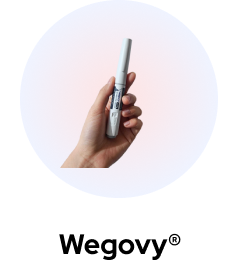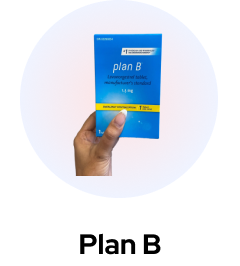Semaglutide has many different brand names, including Wegovy and Ozempic. If you’ve got questions around using the prescription drug, then no doubt you’ll be wondering about the differences between brand names and which is the most effective.
You may also be wondering which has been on the market for a longer time? Which is costlier than the other? Is either drug contraindicated in certain patient populations?
In this article we’ll cover:
- What Wegovy is
- What Ozempic is
- How effective Wegovy vs. Ozempic is
- The side effects of both
- The recommended dosage information for both
- Whether these drugs have any interactions
- Which one is better for weight loss
- What other drugs are available on the market and how they compare
- Frequently asked questions.
Ready to learn more? Let’s dive in!
What Is Wegovy?
Wegovy is an injectable prescription medication for the treatment of obese individuals to assist with weight management. Along with other lifestyle interventions, including a healthy diet and regular exercise, it can be an extremely effective weight management tool.
It’s suitable for adults with a BMI (body mass index) of 30 or over, or of 27 or over with a weight-related medical problem. It can also be used for children over 12 with a BMI equal to or higher than the 95th percentile.
The active ingredient in Wegovy is semaglutide, which mimics the natural glucagon-like peptide-1 (GLP-1) class receptor agonist in the body. In addition to assisting the pancreas with insulin production (which is why this drug is often used in the treatment of those with type 2 diabetes), it also affects signals sent to the brain around fullness and satiety.
In this way, Wegovy helps to suppress hunger, as well as delay gastric emptying. Together, both of these things enable those using semaglutide to achieve their weight management goals, even more so when paired with a healthy diet and exercise.
What Is Ozempic?
Ozempic is another injectable prescription medicine, primarily used for the treatment of type-2 diabetes in adults, though it may also be prescribed to those with a BMI of 27 or above. It is most effective when used alongside diet and physical activity.
Ozempic’s active ingredient is also semaglutide. As with Wegovy, it mimics GLP-1 and works to stimulate insulin production, which assists with glycemic control. It also has the same benefits as Wegovy when it comes to weight management.
In addition to the other benefits we’ve already discussed, using Ozempic may reduce the risk of major cardiovascular events (such as heart attack, stroke, and death) in adults with known cardiovascular disease and type-2 diabetes.
Those with type-2 diabetes are often at higher risk of heart disease thanks to a propensity towards high blood pressure (hypertension), high cholesterol, and obesity.
Similarities Between Wegovy and Ozempic
Both Wegovy and Ozempic, developed by Novo Nordisk, have the same active ingredient of semaglutide.
Semaglutide is a GLP-1 receptor agonist. This means its effects include increasing insulin release (which reduces blood sugar) and decreasing appetite.
To the brain, semaglutide is similar to an appetite hormone.
Wegovy and Ozempic have the same method of administration: a once-weekly injection with a pre-dosed pen. They’re also associated with some similar side effects.
Be sure to pay attention to any disclaimers: Wegovy and Ozempic have similar major risks associated with them. This includes thyroid tumors (thyroid cancer).
Signs of thyroid tumors or cancer include:
- Neck swelling
- Hoarseness
- Trouble swallowing
- Shortness of breath.
Studies involving semaglutide on rodents resulted in some developing thyroid tumors, though it’s unknown if the same effect would be true of humans. To be safe, patients with a personal or family history of medullary thyroid carcinoma should not use semaglutide.
Additionally, patients with any allergies to ingredients, or who are pregnant or planning to conceive should avoid semaglutide.
If you develop acute pancreatitis or hypersensitivity reactions, discontinue your use of the drug immediately and contact your medical team, or go to your local ER.
The main difference between Wegovy and Ozempic is the condition the drug is indicated for, as approved by Health Canada.
Wegovy is indicated for chronic weight management. It’s indicated for adults who are obese (with a BMI of 30 or over), or those who are overweight (with a BMI of 27 or over) and have a weight-related condition.
Ozempic is indicated in adjunct with exercise and diet for the treatment of adult patients with type-2 diabetes.
Another difference is that Wegovy has a higher dosage of semaglutide than Ozempic does, and is associated with more adverse events.
Effectiveness of Wegovy vs. Ozempic
So, knowing that Wegovy and Ozempic have the same active ingredient, which is more effective? Do they have a different mechanism of action or better safety profile?
Wegovy’s efficacy was studied with 4 clinical trials, with 3 focused on the efficacy of weight loss over 68 weeks. In all of the trials, there was a statistically significant weight loss after the 68 weeks.
Patients without type-2 diabetes or intensive behavioral therapy lost 11.5% to 13.4% more weight with Wegovy than the placebo. The participants’ average weight loss on Wegovy was 14.9 kg.
Patients with type-2 diabetes lost between 5.2% and 7.3% more weight with Wegovy than the placebo. Those participants’ average weight loss on Wegovy was 9.6 kg.
Ozempic’s efficacy and safety was studied in 7 clinical trials on patients with type-2 diabetes. Four studies focused on efficacy.
Blood sugar levels were decreased more effectively with Ozempic than with sitagliptin, exenatide, insulin glargine, or a placebo and showed significant results in diabetic patients.
Compared to a placebo, 0.5 mg Ozempic had on average 0.8% to 1.4% higher reduction of blood sugar levels. 1 mg Ozempic had on average a 1.3% to 1.8% higher reduction.
Body weight was also decreased with Ozempic. With a placebo after 30 weeks, the average weight reduction was 1.2 kg, while 0.5 mg Ozempic led to a 3.5 kg body weight reduction, and 1 mg led to a 6.0 kg weight reduction.
As you can see, while it may appear that Wegovy shows quicker onset of action, remember that the clinical trial period for Wegovy than Ozempic was twice as long. In actuality, once we analyze them, their results are very similar.
Side Effects of Wegovy vs. Ozempic
Both Wegovy and Ozempic have some side effects to be aware of. Not everyone will experience every side effect, but a lot of people may experience one or more common ones.
Be sure to talk to a healthcare provider about any side effects which bother you, or don’t go away.
Some of the rarer and more serious side effects of both Ozempic and Wegovy include:
- Inflammation of the pancreas (pancreatitis)
- Gallbladder problems
- Changes in vision in people with type-2 diabetes
- Higher risk of low blood sugar (hypoglycemia), in people with type-2 diabetes
- Serious allergic reaction. Signs include:
- Swelling on the face and throat
- Problems with breathing or swallowing
- Skin rash or itching
- Fainting or feeling dizzy
- Very fast heartbeat
- Kidney problems (kidney failure).
Wegovy also has some other serious side effects, including:
- Increased heart rate (a fast heartbeat)
- Depression and thoughts of suicide.
If you experience any of the above serious side effects on either Ozempic or Wegovy, discontinue your use of the drug immediately and contact your medical team, or go straight to the ER at your local hospital.
Common Side Effects of Wegovy
Some of the common side effects of Wegovy include:
- Nausea
- Diarrhea
- Vomiting
- Constipation
- Stomach pain
- Headache
- Fatigue
- Upset stomach
- Dizziness
- Feeling bloated
- Belching
- Gas
- Heartburn
- Runny nose or sore throat
- Chest pain.
Common Side Effects of Ozempic
Some of Ozempic’s common side effects include:
- Nausea
- Vomiting
- Diarrhea
- Stomach pain
- Constipation.
Dosage for Wegovy vs. Ozempic
All dosages should be followed as prescribed by your medical team.
Wegovy is available as single-use or multi-use pre-filled pens. The dose the pen delivers is 0.25 mg, 0.5 mg, 1 mg, 1.7 mg, or 2.4 mg.
Wegovy is taken once per week. Eventually, the dose should be a maintenance amount of 2.4 mg per week. This should be reached by starting with a 0.25 mg dose, and escalating doses every 4 weeks.
Ozempic is available as a pre-filled pen delivering 0.25 mg, 0.5 mg, 1 mg, or 2 mg doses.
Ozempic is also taken once per week. The starting dosage is 0.25 mg for 4 weeks, then increased to a maintenance dose of 0.5 mg for the duration that the patient is on the drug.
If necessary, your medical team may prescribe a 1 mg or 2 mg dose for extra blood sugar control.
Drug Interactions of Ozempic and Wegovy
Since Ozempic and Wegovy have the same active ingredient, semaglutide, their interactions with other drugs are similar.
Semaglutide delays gastric emptying, which means the time it takes for food to leave the stomach will be slower. However, clinical trials were carried out to test the effect of semaglutide on absorption for several common drugs, finding that there weren’t relevant changes in the absorption of any of them.
Semaglutide also causes an increase in heart rate, and an increase in the PR interval. Its interaction with other drugs increasing heart rate hasn’t been evaluated, though. Neither has its interaction with other drugs increasing the PR interval.
When Wegovy or Ozempic is used along with insulin secretagogue or insulin, the risk of hypoglycemia may be increased.
If you find that semaglutide is not a compatible diabetes management drug for you, talk to your medical team, as there may be others they will be able to recommend.
Wegovy vs. Ozempic. Which Is Better for Weight Loss?
For patients with type-2 diabetes, Wegovy is more effective for weight management than Ozempic. It’s a drug which is indicated specifically for weight loss.
Thanks to the fact that Ozempic is only available for weight management in those with type-2 diabetes and a BMI of 27 or over, there haven’t been extensive studies done on the drug as a tool for weight management in those without type-2 diabetes.
Always follow the information and prescription provided by your medical team, and be sure to disclose your full medical history to them so that they may better treat you.
Wegovy and Ozempic Compared to Other Drugs
Saxenda
Saxenda has similar usage criteria to Wegovy, and similarly works better when combined with lifestyle changes. Where Wegovy is a higher dosage of semaglutide for weight management, Saxenda is a higher dose of liraglutide for weight management.
Liraglutide has been shown to be less effective than semaglutide for weight management. On semaglutide, participants lost 15.8% of their weight on average, while on liraglutide, participants lost 6.4% on average.
Mounjaro
Unlike most type-2 diabetes drugs, which are GLP-1 agonists, Mounjaro (with the active ingredient tirzepatide) is both a GLP-1 and glucose-dependent insulinotropic polypeptide (GIP) receptor agonist.
Tirzepatide has been shown to be more effective than semaglutide both for blood sugar reduction and weight management. Patients lost approximately 1.9 kg more weight on 5 mg Tirzepatide, 3.6 kg on 10 mg, and 5.5 kg on 15 mg.
However, serious adverse events were reported in 5%–7% of patients receiving Tirzepatide, compared to 3% of those receiving semaglutide.
Mounjaro is already approved for the treatment of type-2 diabetes and is under fast-track approval for weight management assistance.
Rybelsus
Rybelsus is another drug with semaglutide as its active ingredient. Instead of an injection pen like Ozempic and Wegovy, Rybelsus is taken as an oral pill.
Like Ozempic, Rybelsus is approved for treating type-2 diabetes but the amount of semaglutide which can be absorbed by the body is less, thanks to the method of intake. Rybelsus may be preferred by patients who are needle-adverse, however.
Rybelsus comes in 3 mg, 7 mg, and 14 mg doses. The 0.5 mg dose of Ozempic is approximately equivalent to 14 mg of Rybelsus. Patients may switch between Rybelsus and Ozempic at those equivalent dosages.
Key Takeaways
Wegovy and Ozempic are prescription medications with the active ingredient semaglutide. Wegovy is indicated for weight management, while Ozempic is indicated for type-2 diabetes or as a weight management tool in those with a BMI of 27 or over. Both should be taken alongside lifestyle intervention measures, including implementing a healthy diet and regular exercise.
Though Wegovy and Ozempic have the same active ingredient, the medications are approved for different conditions. Additionally, the side effects for both Wegovy and Ozempic are very similar.
While Wegovy may be more effective for weight management, it has a higher dosage and associated side effects, both common and more severe.
For patients with type-2 diabetes, Wegovy led to an average of 9.6 kg weight loss, while Ozempic led to an average 6.0 kg weight loss.
Whether you should use Wegovy or Ozempic, or another drug, will depend on your situation. If you’re considering using any drugs for weight management, talk to your medical team, who will be able to make an assessment and determine the best solution for you.
FAQs
Can Wegovy and Ozempic be used together for better results?
No, you should not use Wegovy and Ozempic together. A stated limitation of Wegovy’s use is that it shouldn’t be used in combination with other drugs containing semaglutide. This includes Ozempic.
What precautions should be taken when switching from Wegovy to Ozempic?
Semaglutide shouldn’t be taken if it’s been less than two days (48 hours) since your last injection. Be careful to follow your medical team’s advice for prescriptions and dosages. Otherwise, Wegovy and Ozempic are very similar as medication.
Is there a significant cost difference between Wegovy and Ozempic?
The out-of-pocket cost difference between Wegovy and Ozempic will depend on your insurance plan and what you’re being treated for. Contact your insurance provider for details and to find out if you’re covered.













 (US)
(US)